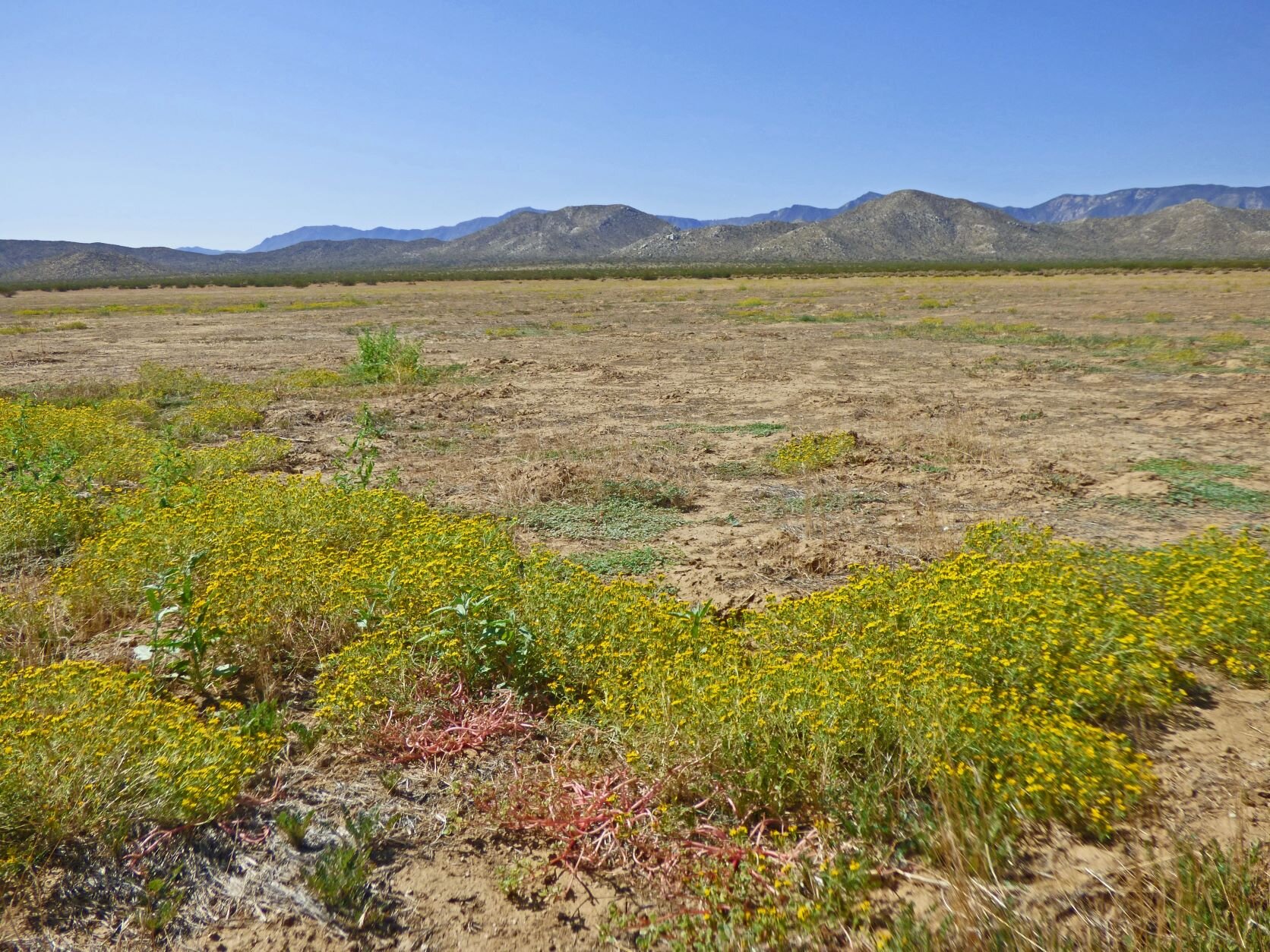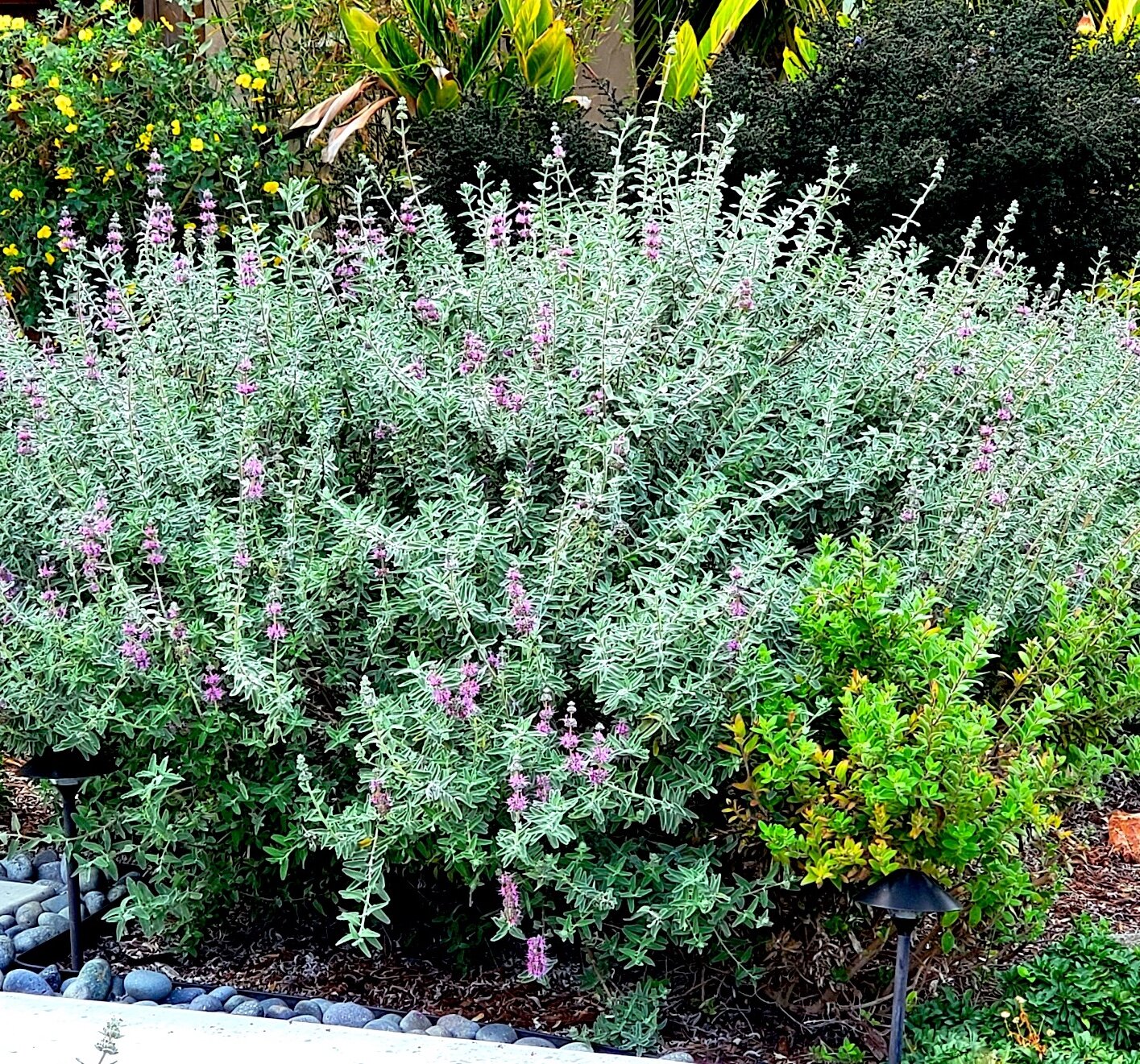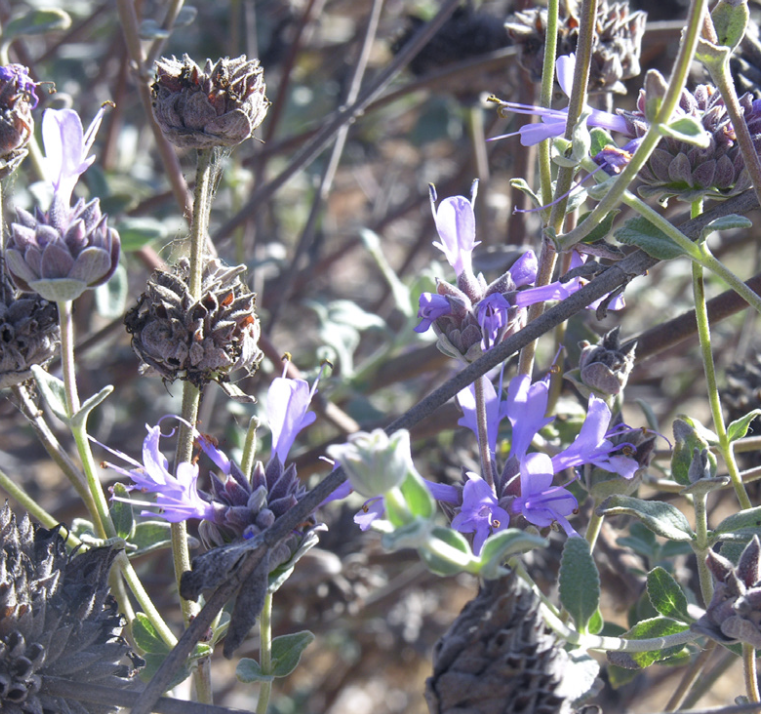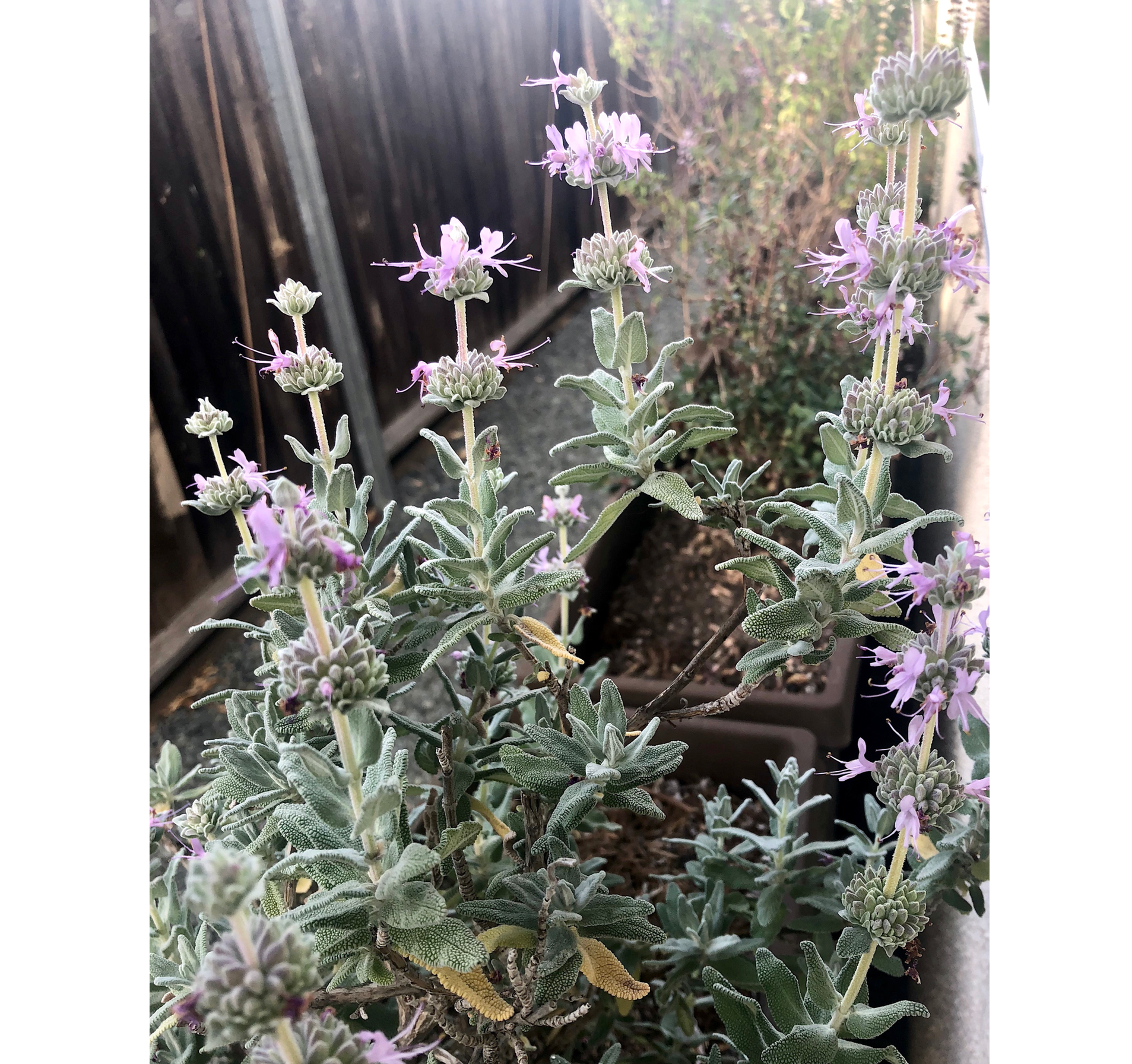This past week I took a virtual garden tour by going through photos from past CNPS Garden Tours. The gardens were just beautiful, and a common thread throughout was the use of manzanitas as the backbone of their designs. With their sculptural form, mahogany-colored bark, thick evergreen leaves, abundant pink and white flowers, and red berries, the manzanitas made superb foundation plants in every area of these gardens. When one adds the advantages of easy care, drought tolerance, and habitat value to their season-round beauty, isn’t it obvious that manzanitas should be the Number 1 pick in every California garden?
California is home to most of the world’s 100-plus manzanita species. There are more than 40 species native to California, along with dozens of subspecies, cultivars, and hybrids, ranging from tree forms reaching 25 feet tall to ground-hugging forms rising only a few inches off the ground.
Manzanitas are well adapted to our hot, dry summers and cooler, wetter winters. Most tolerate clay soils very well, with the exceptions being the more coastal species. Manzanitas are highly dependent on mycorrhizae, a symbiotic fungus that works with the roots to pull nutrients and moisture from the soil, thus allowing the plants to survive in very poor and dry soil. However, it makes manzanitas very susceptible to overwatering and fertilizing: they do not like being deeply watered in the summer or fertilized at any time. They do, however, enjoy an occasional brief shower—just enough to rinse off their leaves—during our long, hot summers.
Manzanitas bloom in winter, and their flowers contain a high-quality nectar, a very important food source for hummingbirds, butterflies, and insect pollinators when not much else is blooming in the landscape. Manzanita (Spanish for “little apple”) is named for the beautiful little berries that grace the plants in spring and early summer. The berries are an important food source for birds, bears, coyotes, and gray fox. The scientific name of the manzanita genus, Arctostaphylos, is based on the Greek words for “bear” and “grape.” Indigenous Californians ground the berries to make a coarse meal and soaked the berries and branch tips to make a delicious cider. The cider tastes great on a warm spring day!
Even when manzanitas are not bearing fruits or flowers, they maintain their beauty through their sturdy evergreen leaves and their lustrous bark that, depending on the variety, can be mahogany, deep brown, purple, pink, or tan. Their bark has the mysterious capability of staying cool to the touch even in the heat of summer, just like their close relative, the madrone (Arbutus menziesii). I have heard some people refer to both as “refrigerator trees.” Manzanita leaves tend to hold themselves perpendicular to the sun during the hottest time of the day. This minimizes the surface area exposed to the sun, thus conserving moisture in the leathery, waxy leaf.
In the garden, most manzanitas prefer full sun, although some do prefer partial shade. The tree and bush forms do very well in full sun in both coastal and inland gardens. The low, ground-hugging forms tend to prefer partial shade when being used in inland areas. Most are good on slopes. Manzanitas like their space and do not like being crowded by faster-growing plants. Provide them good air circulation by giving them space to grow to their mature size. Most manzanitas are drought tolerant, accepting occasional water, but no standing water. When first establishing your manzanitas, you will need to water them every 7-14 days throughout their first 2 years or so. Once they are established (having doubled or tripled in size), you will need to cut back their watering to once a month or less. Remember only to rinse off the leaves of an established plant in the summer. When researching which variety to choose for your garden, do pay close attention to its mature size, as well as sun and water requirements.
With proper placement, manzanitas require little maintenance. You may selectively prune to reveal the plant’s beautiful structure or to remove dead branches. Be sure to cut back to the collar on the main stem or to a strong side shoot of the branch, avoiding stubs of bare wood that will fail to sprout and may ultimately die. Pruning is best done during the summer when cuts will dry and heal quickly and before dormant buds form. Manzanitas are prone to branch dieback, caused by a naturally occurring fungal pathogen. When removing dead branches or pruning for shape, sterilize pruning shears with alcohol between cuts to prevent the spread of disease. You can also pinch back the tips of branches after the blossoms fade to encourage branching below the flower clusters.
So, now that you’re sold on manzanitas, how do you select which ones to grace your garden? When looking at nursery plant lists, you may find that there are 25 or more varieties of manzanita offered. Pretty overwhelming, no? Well, here is a quick rundown of some of the most garden-worthy manzanitas listed by size in descending order.
TREE FORMS
Dr. Hurd Manzanita (Arctostaphylos ‘Dr. Hurd’)
One of the biggest of the manzanitas with a beautiful multibranched form.
• 15’ tall, 10’ wide
• Tree-like, multi-trunked growth habit
• Full sun
• Slow growth rate
• Does well in clay, adaptable to other soils
• Light green foliage, mahogany bark, white flowers
Austin Griffiths Manzanita (Arctostaphylos densiflora ‘Austin Griffiths’)
Very early blooming, Can be used as a large hedge or as a tree specimen.
• 10’ tall, 6’ wide
• Multibranched, upright growth habit
• Full to part sun
• Moderate growth rate
• Prefers well-draining soil but can tolerate clay
• Glossy gray-green foliage, cherry-red bark, pink flowers
SHRUBS
Louis Edmunds Baker’s Manzanita (Arctostaphylos bakeri ‘Louis Edmunds’)
Blooms very heavily, a show-stopper in winter. Can be shaped into a small tree.
• 6’-8’ tall, 6’ wide
• Shrub, upright growth habit
• Full sun to part shade
• Slow growth rate
• Good in heavy clay, adaptable to other soils
• Grayish-green leaves, purple bark, pink flowers
Lester Rowntree Manzanita (Arctostaphylos ‘Lester Rowntree’)
Leaf shape and color make it stand out from the other manzanitas.
• 6’ tall, 8’ wide
• Mounding shrub
• Full sun
• Slow growth rate
• Prefers well-draining soil
• Blue-green triangular leaves, red-brown bark, dark pink flowers
Del Mar Manzanita (Arctostaphylos glandulosa ssp. crassifolia)
Endangered and threatened in the wild. Likes to scramble over and around rocks and walls.
• 6’ tall, 6’-8’ wide
• Shrub with scrambling growth habit
• Full sun to part sun
• Slow growth rate
• Prefers well-draining soil
• Gray leaves, red bark, whitish pink flowers
• We are currently beginning propagation of a low-growing variety, ‘deLux’, that was selected by Greg Rubin
Ian Bush Manzanita (Arctostaphylos densiflora ‘Ian Bush’)
This plant’s naturally upright, open form and gorgeous bark make it everything to love in a manzanita in a miniature form for a small garden.
• 4’-6’ tall, 3’-6’ wide
• Open, upright form
• Full to part sun
• Moderate to fast growth rate
• Does well in clay, adaptable to other soils
• Green foliage, smooth dark red bark, light pink flowers
Howard McMinn Manzanita (Arctostaphylos densiflora ‘Howard McMinn’)
Easy and reliable, tolerates garden conditions. A mainstay of native landscapers for years. Perfect manzanita for beginners. Can be grown as a hedge, bush, laced out as a mini-tree, or topiary
• 4’-6’ tall, 6’ wide
• Dense and upright, but spreading growth habit
• Full sun
• Slow growth rate
• Does well in clay, adaptable to other soils
• Light green leaves, reddish-brown bark, whitish-pink flowers
LOW SHRUBS
Sunset Manzanita (Arctostaphylos ‘Sunset’)
Tough and very reliable. Very malleable, makes an exuberant subshrub when unpruned. Shear the sides and you can get a 5’-tall hedge; open it up to expose the beautiful red bark and you get a micro-specimen tree. If you shear the top you can keep it at 2’ as a low and wide groundcover.
• 4’-5’ tall, 4’-6’ wide
• Dense, upright, and rounded growth habit
• Full to part sun
• Slow growth rate
• Good in clay, adaptable to other soils
• Bright green leaves (new growth coppery-red), red bark, white flowers
John Dourley Manzanita (Arctostaphylos ‘John Dourley’)
Lovely low-growing hedge or groundcover. Pink flowers contrast beautifully with its soft gray-green foliage. More tolerant of water than many other manzanitas; can use near lawns.
• 2’-4’ tall, 5’-6’ wide
• Low, compact, and dense growth habit
• Full to part sun
• Moderate growth rate
• Good in heavy clay, adaptable to other soils
• Gray-green foliage (new foliage coppery-green), red-brown bark, pink flowers
Fransiscan Manzanita (Arctostaphylos franciscana)
Rock solid and tough as nails from the coast to interior valleys. Great groundcover in the sunny interior where other low-growing manzanitas may not do well. Severely endangered, with possibly only one plant left in the wild.
• 2’-3’ tall, 6’-8’ wide
• Low shrub
• Full to part shade, can take the sun inland
• Slow growth rate
• Good in heavy clay, adaptable to other soils
• Reddish green leaves, red-brown bark, pink flowers
GROUNDCOVERS
Carmel Sur Manzanita (Arctostaphylos edmundsii ‘Carmel Sur’)
Beautiful and refined with a soft texture. More tolerant of water than other manzanitas. Good for transition areas between traditional and water-wise gardens. Recommended for erosion control.
• 1’-2’ tall, 6’ wide
• Mounding groundcover
• Full sun on coast, part shade inland
• Fast growth rate
• Good in clay, adaptable to other soils
• Green leaves (reddish-green new growth), light pink flowers
Wood’s Compact Manzanita (Arctostaphylos uva-ursi ‘Wood's Compact’)
Tolerates more shade than most manzanitas, great under oaks. Dense, dark green with large red berries.
• 1’ tall, 3’-6’ wide
• Low, compact, and dense growth habit
• Full to part sun on coast, part shade to shade inland
• Fast growth rate
• Prefers well-draining soil
• Dark green foliage, pink flowers
Point Reyes Manzanita (Arctostaphylos uva-ursi ‘Point Reyes’)
Great groundcover for the coast, takes more water than other manzanitas.
• 1’ tall, 12’ wide
• Lush, low, and creeping growth habit
• Full to part sun on coast, part shade inland
• Slow growth rate
• Needs well-draining soil
• Some green leaves, some gray leaves, pink flowers
Monterey Carpet Manzanita (Arctostaphylos hookeri ‘Monterey Carpet’)
Best on the coast with well-draining soil, great under pines.
• 1’ tall, 4’ wide
• Low, trailing growth habit
• Full to part shade on coast, part shade inland
• Slow growth rate
• Needs well-draining soil, prefers acidic soil
• Deep green leaves, red stems, white flowers
Please search www.calscape.org for additional manzanita ideas. With all of this variety, there is bound to be a manzanita (or two, or three, or ...!) that is perfect for your garden.
Teresa Everett is a native garden educator and native plant enthusiast. She is a member of the Native Garden Committee, and her home was on the 2018 CNPS-SD Garden Tour. Teresa has worked for Moosa Creek Nursery as a retail sales and gardening specialist and wrote for their blog “Creekside Chat” until 2018. She has also given many presentations on native gardening at nurseries, gardening clubs and conservation organizations.











![Salvia munzii © Dick Culbert [CC BY 2.0]](https://images.squarespace-cdn.com/content/v1/585dc42c725e25ca57806ffc/1612122771948-8O3BLTFJZQY540II2JO4/Salvia+munzii+%C2%A9+Dick+Culbert+%5BCC+BY+2.0%5D+copy.png)
![Salvia leucophylla © John Rusk [CC BY 2.0]](https://images.squarespace-cdn.com/content/v1/585dc42c725e25ca57806ffc/1612122626980-1YA23E40EGSL6G9GOPK5/Salvia+leucophylla+%C2%A9+John+Rusk+%5BCC+BY+2.0%5D+copy.jpg)


![Salvia pachyphylla © Dick Culbert [CC BY 2.0]](https://images.squarespace-cdn.com/content/v1/585dc42c725e25ca57806ffc/1612122631990-TWYFBJE1EE930WT0RI99/Salvia+pachyphylla+%C2%A9+Dick+Culbert+%5BCC+BY+2.0%5D+copy.jpg)